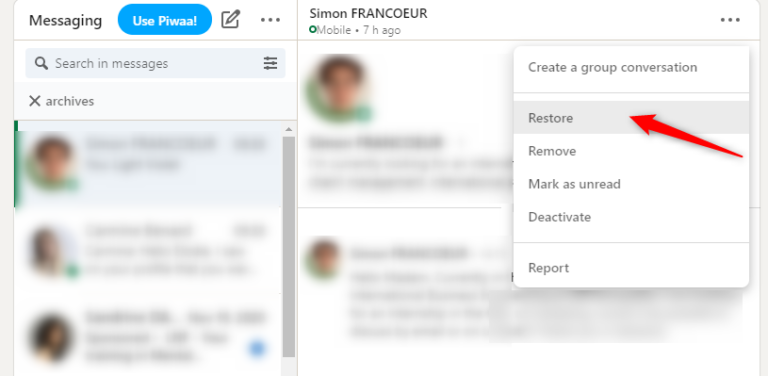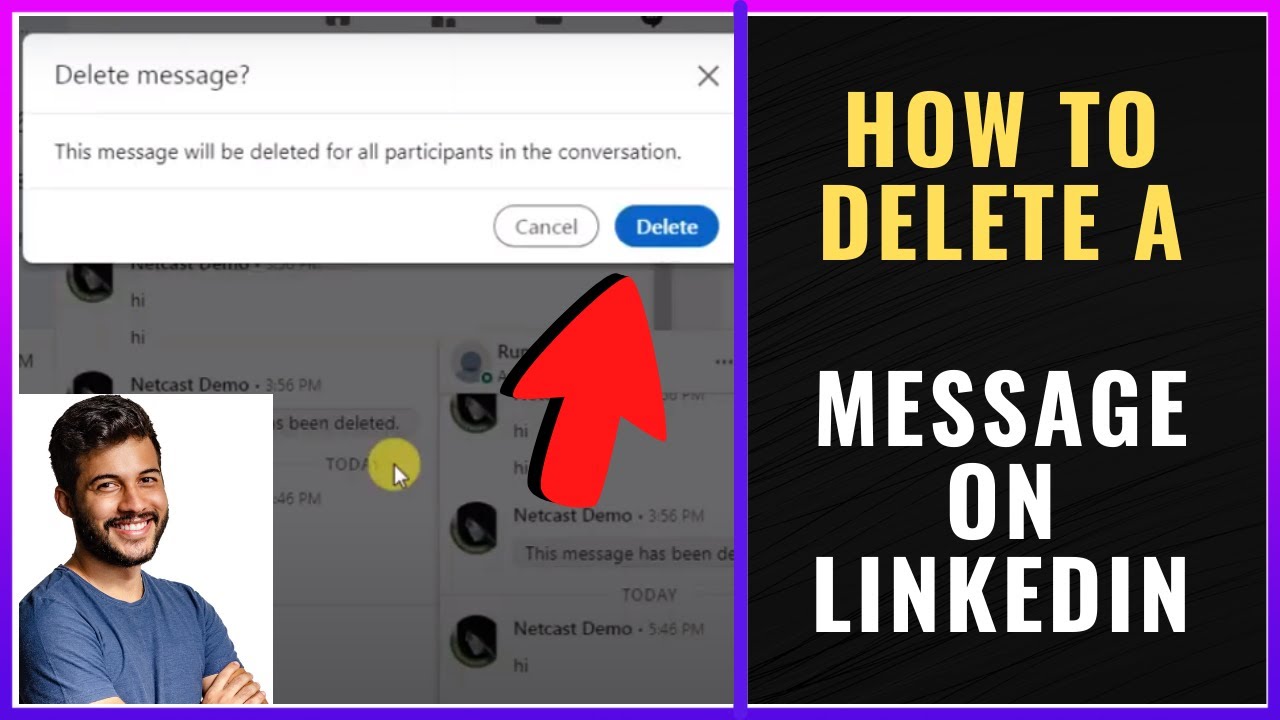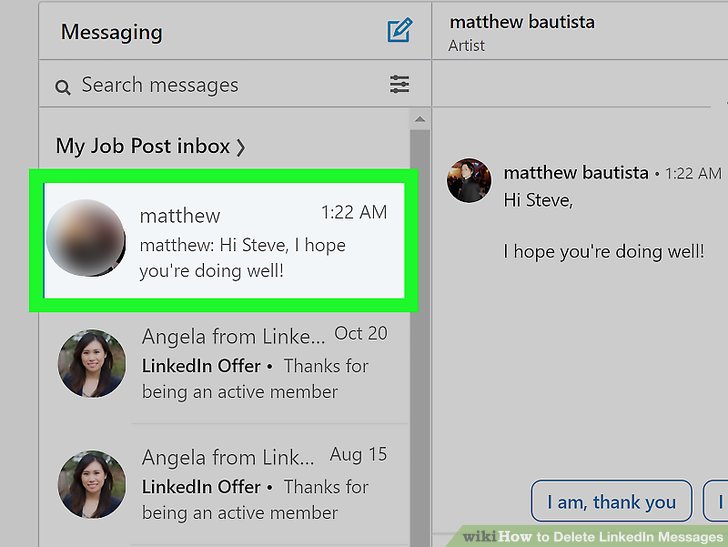LinkedIn messaging is more than just a straightforward chat function; it’s designed to help you network, build professional relationships, and communicate effectively with your connections. Let’s unpack some key features that make the LinkedIn messaging experience unique.
- Direct Messaging: This is the core feature, allowing you to send and receive messages directly from your connections. It’s as simple as clicking on their profile and selecting the message option.
- InMail: For those not in your network, InMail allows you to reach out to them directly. This feature is particularly useful for recruiters or professionals seeking to expand their network.
- Message Filters: To help manage your conversations, LinkedIn provides options to filter your messages by unread, sent, and archived. This is handy for keeping track of important discussions.
- Attachments: You can send files and documents over LinkedIn messages, making it easy to share your resume, presentations, or any other relevant materials.
- Emoji and GIFs: Want to lighten the mood? Using emojis or GIFs can add a personal touch to your professional conversations. But remember to keep your audience in mind!
- Audio and Video Calls: With LinkedIn’s messaging feature now integrating video calls, you can take your conversations to the next level without needing to switch platforms.
Understanding these features can help you use LinkedIn messaging effectively. You’ll be able to customize your interactions based on your specific needs and those of your audience.
Why You Might Want to Delete Messages

Now that we've explored LinkedIn’s messaging features, let’s discuss why you might find it necessary to delete messages. Whether you’re looking to tidy up your inbox or simply want to maintain your privacy, deleting messages can be a crucial part of managing your LinkedIn conversations.
- Decluttering Your Inbox: Over time, your LinkedIn messages can pile up. Deleting unnecessary conversations helps create a cleaner, more manageable inbox, allowing you to focus on messages that matter.
- Maintaining Privacy: Sometimes, conversations may include personal information or sensitive topics that you wouldn’t want lingering in your inbox. Deleting these messages ensures that your data remains private.
- Correcting Mistakes: Perhaps you sent a message that was meant for someone else or miscommunicated something important. Deleting the message can help prevent further confusion and correct the record.
- Ending Unproductive Conversations: If a conversation is no longer relevant or productive, don't hesitate to delete it. This can save mental space and allow you to focus on more fruitful interactions.
- Professional Reputation: In some cases, you might want to maintain a certain image or professionalism on LinkedIn. Removing messages that don't align with that image can be beneficial.
Ultimately, the decision to delete messages on LinkedIn comes down to your individual circumstances and preferences. Understanding the "why" behind this choice can lead to more thoughtful and intentional use of the platform.
Also Read This: How to Remove Someone from LinkedIn
3. Step-by-Step Guide to Deleting Messages on LinkedIn

Deleting messages on LinkedIn might seem a bit tricky at first, especially if you're not familiar with the platform's interface. But don't worry! It's a straightforward process. Here’s a clear, step-by-step guide to help you through it.
- Log into Your LinkedIn Account: Start by opening your web browser or LinkedIn app and logging into your LinkedIn profile.
- Navigate to Your Messaging Section: Click on the Messaging icon, which looks like an envelope. It's usually located in the top menu bar on the desktop version or at the bottom of the screen on mobile.
- Select the Conversation: Once in the messaging section, scroll through your list of conversations to find the one you want to delete. Click on it to open the chat.
- Access Message Options: In the open conversation, look for the three-dot menu (⋮) usually located at the top right or near the message area. Click on this icon to reveal more options.
- Choose the Delete Option: From the dropdown menu, select “Delete Conversation.” A confirmation prompt will appear asking if you're sure you want to delete the conversation. This step is important, as deleting is irreversible!
- Confirm Deletion: Click “Delete” in the confirmation prompt. The conversation will be permanently removed from your messages.
And there you go! Just remember, deleting messages means that you will lose any valuable information or connections shared in that conversation. So, proceed wisely. If you find yourself frequently cleaning out your messages, it may be helpful to regularly archive or save important conversations elsewhere before hitting that delete button.
Also Read This: Where to Add Resume to LinkedIn: A Quick Guide for Adding Your Resume to Your Profile
4. Tips for Managing LinkedIn Conversations Effectively

Managing conversations on LinkedIn is crucial, especially if you're utilizing the platform for networking, job hunting, or business purposes. Here are some practical tips to help you keep your LinkedIn messaging organized and effective:
- Prioritize Your Conversations: Use LinkedIn's ability to 'pin' important conversations. This way, you can keep crucial messages at the top of your chat list, making them easy to access later.
- Set Aside Regular Check-In Times: Dedicate specific times each week to check your messages. This practice helps you stay organized and not overlook any important communications.
- Respond Promptly: If someone messages you, try to respond within 24 hours. Quick replies show professionalism and courtesy, making a positive impression.
- Leverage LinkedIn’s Search Function: If your messages start piling up, use the search feature within LinkedIn messaging to find previous conversations quickly. Just type in keywords related to the conversation you're looking for!
- Be Concise and Clear: When sending messages, keep them brief and to the point. This increases the likelihood of getting a response and shows respect for the recipient’s time.
- Follow-Up: If you haven’t received a reply after a week or so, don’t hesitate to send a friendly follow-up message. Sometimes, messages get lost or overlooked!
- Maintain Professionalism: Remember, LinkedIn is a professional network. Keep your tone polite and the subject matter relevant to professional interests. Avoid over-familiarity unless you have an established relationship.
By implementing these tips, you can streamline your LinkedIn messages, ensuring that you not only manage your conversations effectively but that you also nurture valuable professional relationships. Happy networking!
Also Read This: Can You Block Companies on LinkedIn? A Guide to Managing Your Feed
5. What to Do if You Can't Delete a Message
So, you've attempted to delete a message on LinkedIn, but for some reason, it just won't budge. Don’t worry; this can happen, and there are several reasons why you might be facing this hiccup. Let’s go through a few steps to troubleshoot and understand your options.
First, it's essential to ensure that you're logged into the correct account. Sometimes, we might switch between accounts, especially if you manage multiple profiles or are using a professional versus a personal account. Once you confirm you're on the right account, try these suggestions:
- Check Your Internet Connection: A poor connection can hinder your ability to execute actions on LinkedIn. Refresh your page or switch networks and give it another go!
- Update Your App: If you're using the LinkedIn mobile app, make sure it’s updated. Outdated apps can lead to glitches. Head to your app store to see if there's a new version available.
- Clear Cache and Cookies: If you're using a browser, try clearing your cache and cookies. Sometimes, stored data can interfere with how sites function.
- Use a Different Browser: Occasionally, the browser you’re using may cause issues. Try accessing LinkedIn from a different browser to see if the problem persists.
Even after trying these tips, if you're still unable to delete a message, it might be a limitation of the platform’s functionality. There are some messages that you cannot delete, particularly those in groups where you don't have control over the full conversation. In such cases, consider the following:
- Archiving Conversations: If it’s about hiding the message instead of deleting, you could archive the conversation to tidy up your inbox without removing it entirely.
- Contacting LinkedIn Support: If you believe you should be able to delete the message—in cases of technical issues or bugs—don’t hesitate to contact LinkedIn support. They can provide insights specific to your situation.
Remember, it's okay to encounter these bumps in the road. Just stay calm, and hopefully, one of these suggestions will get you back on track.
Also Read This: Finding All Your LinkedIn Posts: A Quick Guide for Users
6. Best Practices for LinkedIn Messaging Etiquette
LinkedIn is a powerful platform for networking and making professional connections, but like any social space, it comes with a set of unwritten rules. Practicing good messaging etiquette not only reflects your professionalism but can also enhance your networking opportunities. Let’s dive into some best practices for messaging on LinkedIn.
1. Personalize Your Messages: Avoid generic greetings and messages. Always personalize your approach. Mention how you found the person (e.g., through a mutual connection or a LinkedIn group) and why you want to connect. This shows that you value their time and are not just sending a blast message.
2. Keep It Concise: Time is precious, especially in the professional world. Keep your messages short and to the point. A good rule of thumb is to get to the purpose within the first two or three sentences.
3. Be Respectful and Professional: Your tone should reflect professionalism. Avoid using slang, and always remember to say "please" and "thank you." It sets a positive tone and fosters respect in your conversations.
4. Use Clear Subject Lines: If you’re sending connection requests or direct messages, having a straightforward subject line can grab attention. It gives a clear idea of what your message entails before they even open it.
5. Follow Up, But Don’t Persist: If you haven’t heard back after a week or two, it’s perfectly acceptable to send a polite follow-up. However, if they don’t respond after that, respect their space. No one likes feeling pressured to respond.
6. Know When to Move It Offline: If you're having extensive discussions, especially about potential collaboration, consider suggesting a phone or video call. This can often lead to more productive conversations.
By adhering to these best practices, you can create a positive impression and foster meaningful connections on LinkedIn. Remember, messaging isn’t just about sending a note; it's about building relationships. Happy networking!
Conclusion: Keeping Your LinkedIn Messaging Organized
In today’s professional world, maintaining a clean and organized messaging system on LinkedIn is essential for effective networking and communication. When your inbox is cluttered, important messages can easily get lost or overlooked. Here are some tips to help streamline your LinkedIn messaging:
- Regularly Archive or Delete Conversations: After you’ve resolved a conversation or no longer need it, consider archiving or deleting the messages to keep your inbox tidy.
- Use the Search Function: LinkedIn's search tool allows you to quickly find specific conversations or important messages, saving you time.
- Labels and Flags: Although LinkedIn doesn’t offer labels in the same way email does, you can create a system for recognizing important conversations, such as responding promptly to job inquiries.
Another valuable method is to categorize your LinkedIn messages based on the relationship or purpose. Here’s a simple table to visualize how you might prioritize your responses:
| Category | Action |
|---|---|
| Job Inquiry | Respond within 24 hours |
| Networking | Follow up after one week |
| General Updates | Review monthly |
By implementing these strategies, you will not only keep your LinkedIn messaging organized but also enhance your professional communication efficiency. A tidy inbox translates to better networking opportunities and less stress!
 admin
admin








